Spatial Manager Desktop™ - FAQs: Maps, layers, views
Notes:
- Some components in the images on this page (providers, names, windows look, etc.) may be slightly different from those that will appear on your computer
- Some application functions need to access the Internet from the application itself. If you experiment problems in any process, ask your network administrator if there is a Proxy server installed on your network. You can configure the Proxy settings through the application options
- Some geographic data providers (Geocode, image Maps, etc.) may need a user account, which you can configure in the Service Provider API Keys settings through the application options
Introduction
- Objective of this section
- To use maps and workspaces. To manage the layers that include the maps. To modify the visual appearance of layers and maps. To navigate through the maps using certain tools to change the display views
- Topics in this section
- Maps and workspaces: opening and saving maps, workspace organization and management of maps and map backgrounds
- Layers. Management and styles: arrangement of layers, layer visualization, defining the selected layer, modifying styles (borders, fills and patterns, lines, point styles and transparency) and user symbols
- Views and navigation: navigation tools, views and using mouse controls
- Maps and layers properties
How can I open a Map?
You can open a Map in Spatial Manager Desktop™ by using the function "Open", in the "Start" ribbon, and selecting the file *.spm to open, by double-clicking on an *.spm file in the Windows explorer or by right-clicking on an *.spm file and selecting "Open" in the Windows explorer
Spatial Manager Desktop™ uses *.spm as the Map files extension and the internal structure of these files is based on SQLite database files
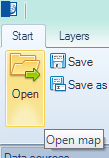
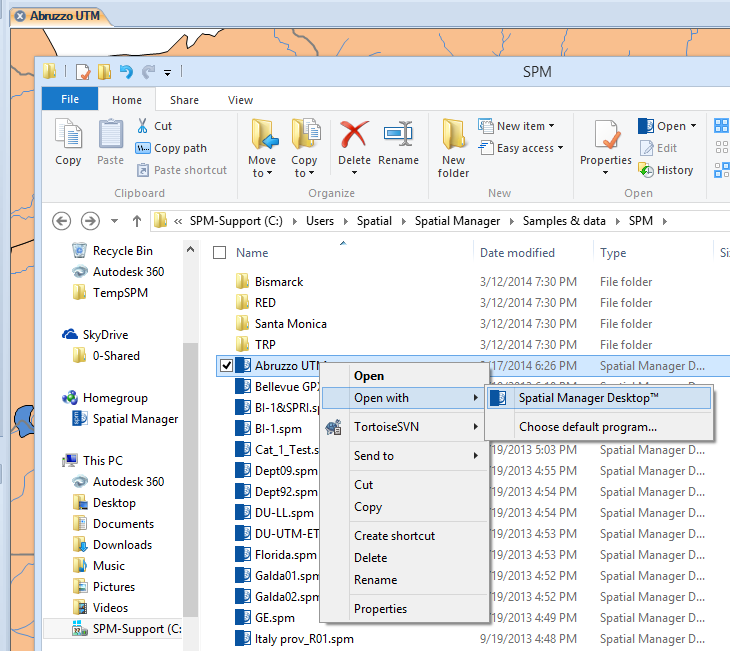
How can I handle one Map or multiple Maps?
You can keep open as many Maps as you want in Spatial Manager Desktop™ (only limited by the amount of your system memory), each one located inside its own Workspace. Using the Tabs in the Workspaces, you can:
- Sort the Workspaces: by dragging and dropping the Tab of a Map to the desired location
- Use the Workspaces contextual menu (mouse right-click on the Tab) to:
- Open another Map (Open map). It will be open in a new Workspace
- Save the Map under your right-clicked Tab (Save map)
- Save the Map under your right-clicked Tab using a different name and/or at another location (Save map as)
- Save all open Maps (Save all maps)
- Close the Map under your right-clicked Tab (Close). You will get a warning if this Map has changed
- Close all open Maps (Close all). You will get a warning for every modified Map to close
- Close all open Maps except that is under your right-clicked Tab (Close all except this one). You will get a warning for every modified Map to close
- Copy the file path of the Map under your right-clicked Tab to the Windows clipboard (Copy map file path). This function will be disabled if the Map is a new Map and has not been saved yet
- Open the folder containing the file of the Map under your right-click Tab (Open map file location). This function will be disabled if the Map is a new Map and has not been saved yet
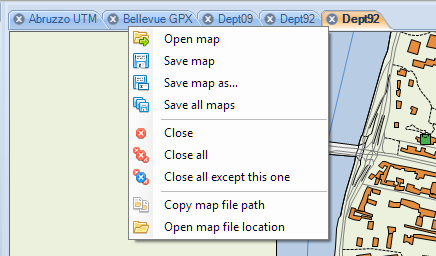
How can I stylize a Map?
You can stylize the Layers in a Map and the Map background in Spatial Manager Desktop™. These parameters will be saved when you save the Map
- To stylize a Layer in the Map, go to the "Layers" ribbon, select a Layer and apply styles as follows:
- Set up the fill style parameters for polygonal type Features (if any, in the Layer)
- Select the fill pattern
- Select the foreground color (except if you have chosen the "Solid" pattern)
- Select the background color
- Select the opacity/transparency for the background
- Select the line style for the edge (stroke width and stroke style), and select whether or not you want to draw the edge
- Set up the line style parameters for linear type Features (if any, in the Layer)
- Select the line style (stroke width and stroke style)
- Set up the point style for point type Features (if any, in the Layer)
- Select the point type from the predefined point types list or by selecting an image from disk and by defining its insertion base (this image will remain in the point type list, along with the current instance of the application, to select it whenever you want)
- Set up the fill style parameters for polygonal type Features (if any, in the Layer)
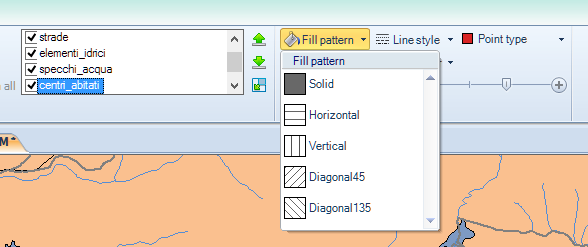
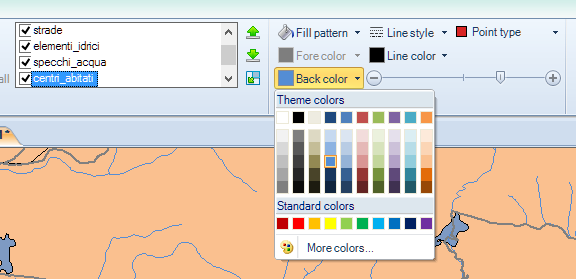
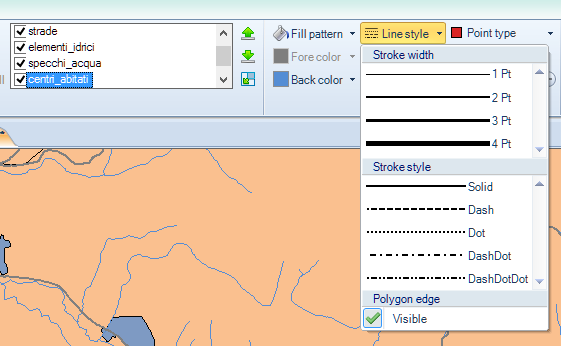

- To change the Map background, go to the "Start" ribbon. You can choose:
- A preset or user-defined base map from some base map providers (requires an Internet connection)
- Note: to use a base map as Map background, the Map must have defined a Coordinate System (see below)
- A solid color
- Restore the default solid color set in the application configuration
- A preset or user-defined base map from some base map providers (requires an Internet connection)
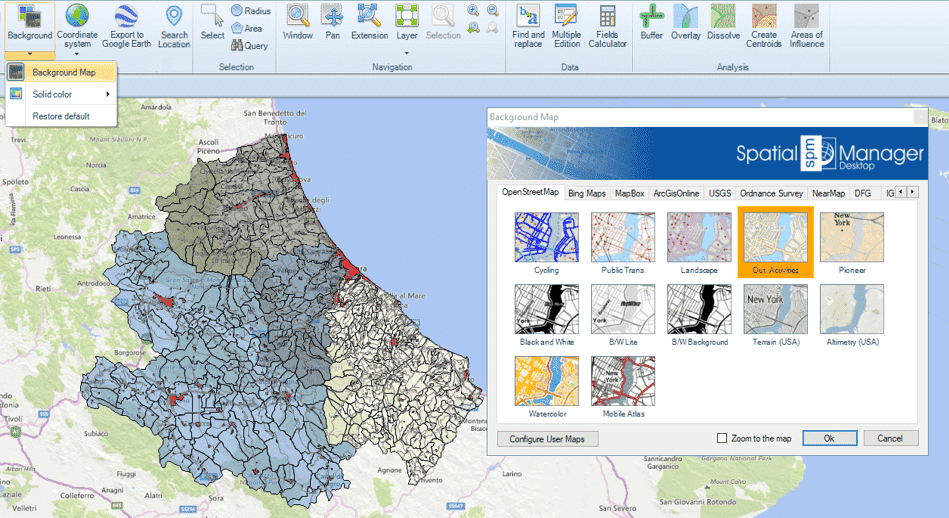
The option "Zoom to the map" changes automatically the Map view to the 'Background Map' extent, defined in the server
To learn more about 'Background Maps' and how to configure User maps, take a look to the Background Maps page
Can I set up any default style value for new Maps or new Layers?
Yes, in the "Options\Workspaces" window of Spatial Manager Desktop™ you can set up some default style values for new Maps or new Layers:
- Default Map background solid color
- Layer style defaults:
- Default line color
- Default fill background color. For this parameter, you can choose a "Fixed color" or the "Random color" option, which lets the application apply random background colors for polygons in new Layers
- Default point style, that you can choose from the predefined point types list
Furthermore, you can choose the "Antialiasing" option, to display the Maps on the screen using a "smoothing" mode

How can I sort the relative position of the Layers in a Map?
You can sort the position of the Layers in a Map in Spatial Manager Desktop™ simply by selecting the Layer to move and dragging and dropping it on the Layer list of the ribbon "Layers". Also you can select the Layer to move and use the up and down arrows at the right of the Layer list. The content of the upper Layers will be drawn above the content of the lower Layers in the Maps
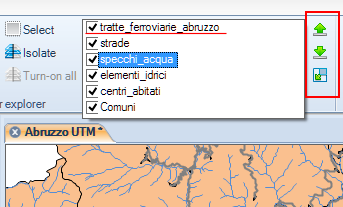
Can I expand the list of Layers in a Map?
Yes, if you need to expand the list of Layers in a Map in Spatial Manager Desktop™, click-on the "Drop down layer list" button, next to the Layer list. You can also select or sort Layers in the expanded list
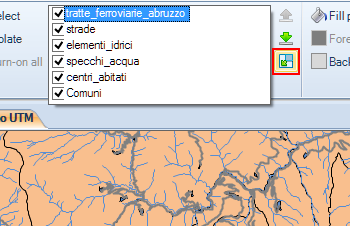
How can I select a Layer in a Map?
You will select a Layer in a Map in Spatial Manager Desktop™ by clicking-on its name in the list of Layers in the "Layers" ribbon. There will be only one selected Layer in the Map at the same time and the Data grid will show the data of the Features in this Layer. Most functions in the ribbon "Layers" apply only to the selected Layer
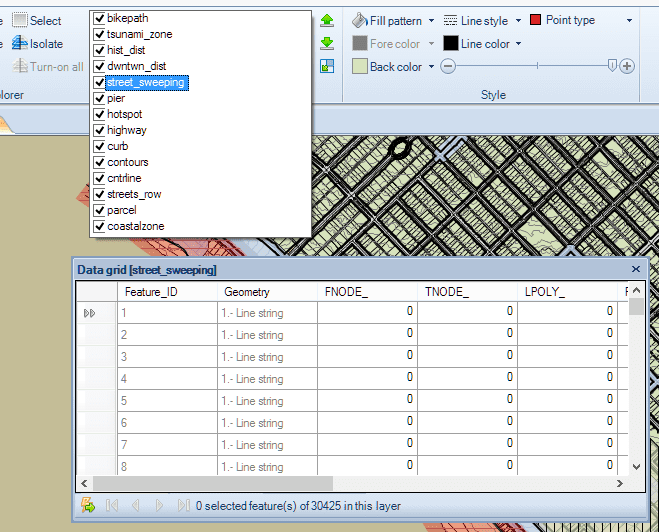
How can I turn on or off a Layer?
You can turn on or off a Layer in Spatial Manager Desktop™ by clicking-on the little box next to the Layer name in the list of Layers in the "Layers" ribbon. You can also use the function "Isolate", in this ribbon, to turn off all Layers except the selected Layer, or the function "Turn-on all" to turn on all Layers in the Map
There must always be one selected Layer, and the selected Layer cannot be turned off, if you turn off the current selected Layer, the first Layer turned on in the Layer list (if any) will now be the selected Layer
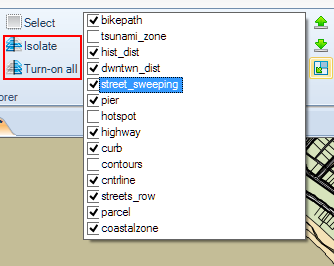
How can I change the view of a Map in a Workspace?
You can change the view of a Map in Spatial Manager Desktop™ choosing different ways to make zooms and pans inside the Workspace:
- Zoom in or zoom out
- Turn the mouse wheel over the place that you want in the Map. One direction of rotation will do zoom in and the opposite will do zoom out
- Click on the "Zoom in" or the "Zoom out" functions in the ribbon ("Start\Navigation") and select the place in the Map to do it
- Zoom in by rectangular window
- Click on this function in the ribbon ("Start\Navigation") and define the window to zoom in
- Click on this function in the contextual menu (right-click) of the Workspace and define the window to zoom in
- Zoom to the Map extension
- Click on this function in the ribbon ("Start\Navigation")
- Click on this function in the contextual menu (right-click) of the Workspace
- Click twice on the mouse wheel when the cursor is over the Map
- Zoom to a Layer
- Click on this function in the ribbon ("Start\Navigation") and select the Layer that you want to zoom
- Click on this function in the contextual menu (right-click) of the Workspace and select the Layer that you want to zoom
- Click on this function in the ribbon ("Layers\Layer explorer") to zoom to the selected Layer
- Zoom to the Features selection (if any):
- Click on this function in the ribbon ("Selection-Tools\Action") to zoom to the current Features selection
- Click on this function in the contextual menu (right-click) of the Workspace to zoom to the current Features selection
- Clicking on the function "Zoom to selection" in the Data grid right-click menu also will zoom to the current Features selection
- The function "Zoom to feature" will zoom to the Feature below the cursor in the Data grid at the right-click time, regardless of which features are selected
- Clicking on the function "Zoom to selection" in the Data grid right-click menu also will zoom to the current Features selection
- Center the Features selection (if any):
- Click on the function "Center selection" in the Data grid right-click menu to center the view on the current Features selection
- The function "Center to feature" will center the view on the Feature below the cursor in the Data grid at the right-click time, regardless of which features are selected
- Click on the function "Center selection" in the Data grid right-click menu to center the view on the current Features selection
- Pan
- Click on this function in the ribbon ("Start\Navigation") and drag the cursor through the Workspace
- Click on this function in the contextual menu (right-click) of the Workspace and drag the cursor through the Workspace
- Press the mouse wheel and drag the cursor through the Workspace
- Go to the "Previous view" (if any) or the "Next view" (if any): click on these functions in the ribbon ("Start\Navigation")
Some other functions, such as selecting Features in the Data grid or by queries, can make changes in the view of the Map depending on the application configuration
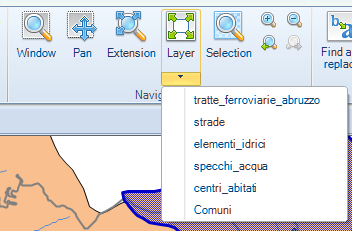
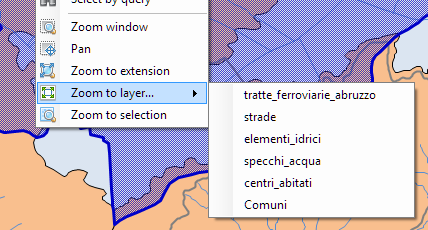
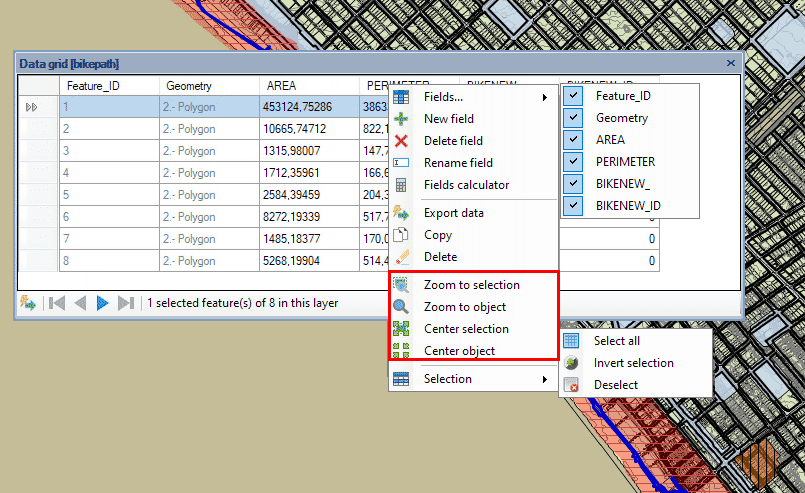
Can I see the Properties of a Map or a Layer?
Yes, you can see the Properties of a Map in Spatial Manager Desktop™ in the "Properties" panel when you set the application focus in the corresponding Workspace by clicking on the Workspace Tab:
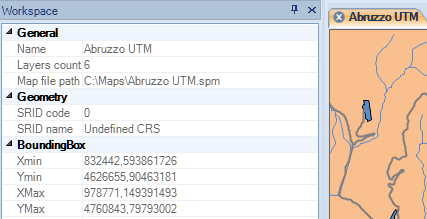
And you can see the Properties of a Layer in the "Properties" panel when you select a Layer in the "Layers" ribbon:
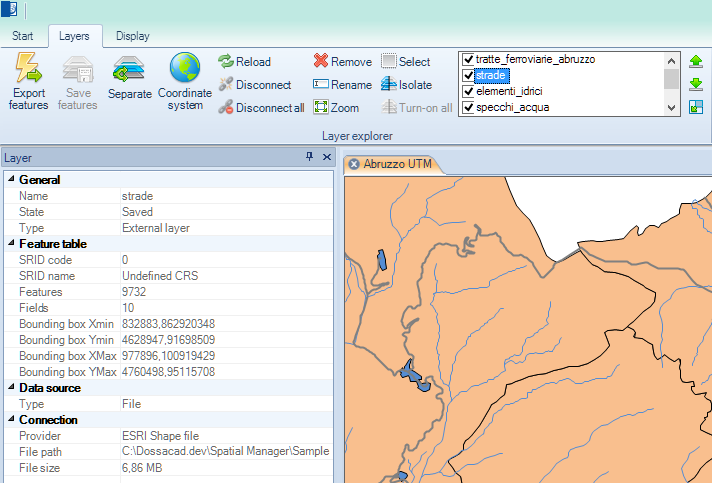
How can I choose the Coordinate System for a Map or a Layer?
You can choose the Coordinate System (CRS) for a Map in Spatial Manager Desktop™ using the "Coordinate system" function in the "Start" ribbon, and for a Layer you will use the "Coordinate system" function in the "Layers" ribbon. Both functions expand menus to select the CRS as follows:
- Map
- Information only: the current CRS defined for the Map. If the Map has not defined a CRS, you will see it as "Undefined". If the current CRS shown is not "Undefined", be careful when modifying it because there must be some reason for this value
- The "Favorite" (last used) Map CRS list (if any)
- The list of the CRSs defined for all the Layers in the Map (if any)
- Access to the CRS Catalog of the application
Note: To unassign (undefine) the Coordinate System of the Map, choose "Undefined CRS" (EPSG 0)
- Layer
- Information only: the current CRS defined for the selected Layer. If the selected Layer has not defined a CRS, you will it see as "Undefined". If the current CRS shown is not "Undefined", be careful when modifying it because there must be some reason for this value
- The "Favorite" (last used) Layer CRS list (if any)
- The list of the CRSs defined for all the Layers in the Map (if any)
- The CRS defined for the Map (if the Map has a CRS defined)
- Only for External Layers: the CRS defined for the data source of the Layer (if any)
- Access to the CRS Catalog of the application
Note: To unassign (undefine) the Coordinate System of a Layer, choose "Undefined CRS" (EPSG 0)
For each CRS in these menus you will see:
- The name of the CRS
- The EPSG number for the CRS (in brackets)
- A tooltip showing the complete description of the CRS
- Note: if the name and the EPSG number of a CRS are greyed in the lists, this means that it is the same CRS as that already selected for the Map or the Layer
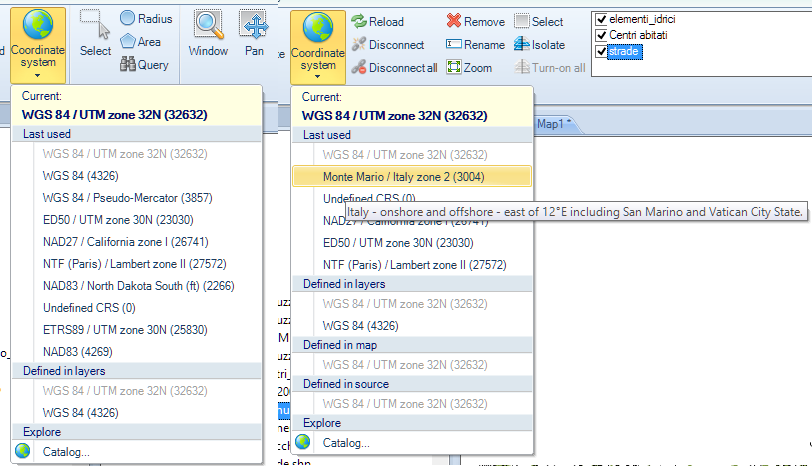
Expanded menus to select CRSs for Maps and for Layers
- Notes:
- To learn more about the use of the CRS Catalog, you can read this paragraph here: Transformation of coordinates
- When a Map has no CRS defined, it will take the CRS from the first Layer which has a CRS defined, so:
- If you are loading new Layers in a Map, the first Layer with a defined CRS will define the CRS for the Map
- If you have a Map without a CRS defined and the Layers neither have their CRSs defined, when you choose a CRS for a Layer, this CRS will also apply to the Map
- Projection on the fly behavior
- As Spatial Manager Desktop™ projects on the fly the Features in the Layers according their CRSs and the CRS of the Map, when you modify these parameters, you will see graphical changes in the Workspace. Be careful when choosing CRSs for the Map and for the Layers because you can apparently "loose" Features of some Layers in the Workspace, if you make wrong or inappropiate selections for these parameters
- The Features in Layers without a CRS defined will not be projected on the fly
- If the Map has no CRS defined, no Features will be projected on the fly. Although usually you should not want to do it, you can disable the "projection on the fly" behavior by selecting the CRS "Undefined CRS" (EPSG 0) for the Map. You can select the "Undefined CRS" (EPSG 0) each time you want to unassign (undefine) the Coordinate System of a Map or a Layer
- The base Map Backgrounds are only available with projected Coordinate Reference Systems
- Coordinate Systems and Transformation details
- Coordinate Systems objects available in the current version
Related links
- See "Layer management " also
- Blog posts